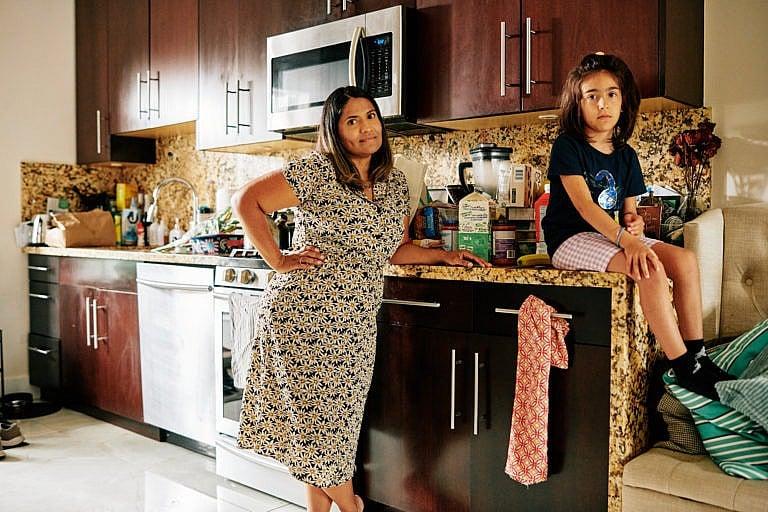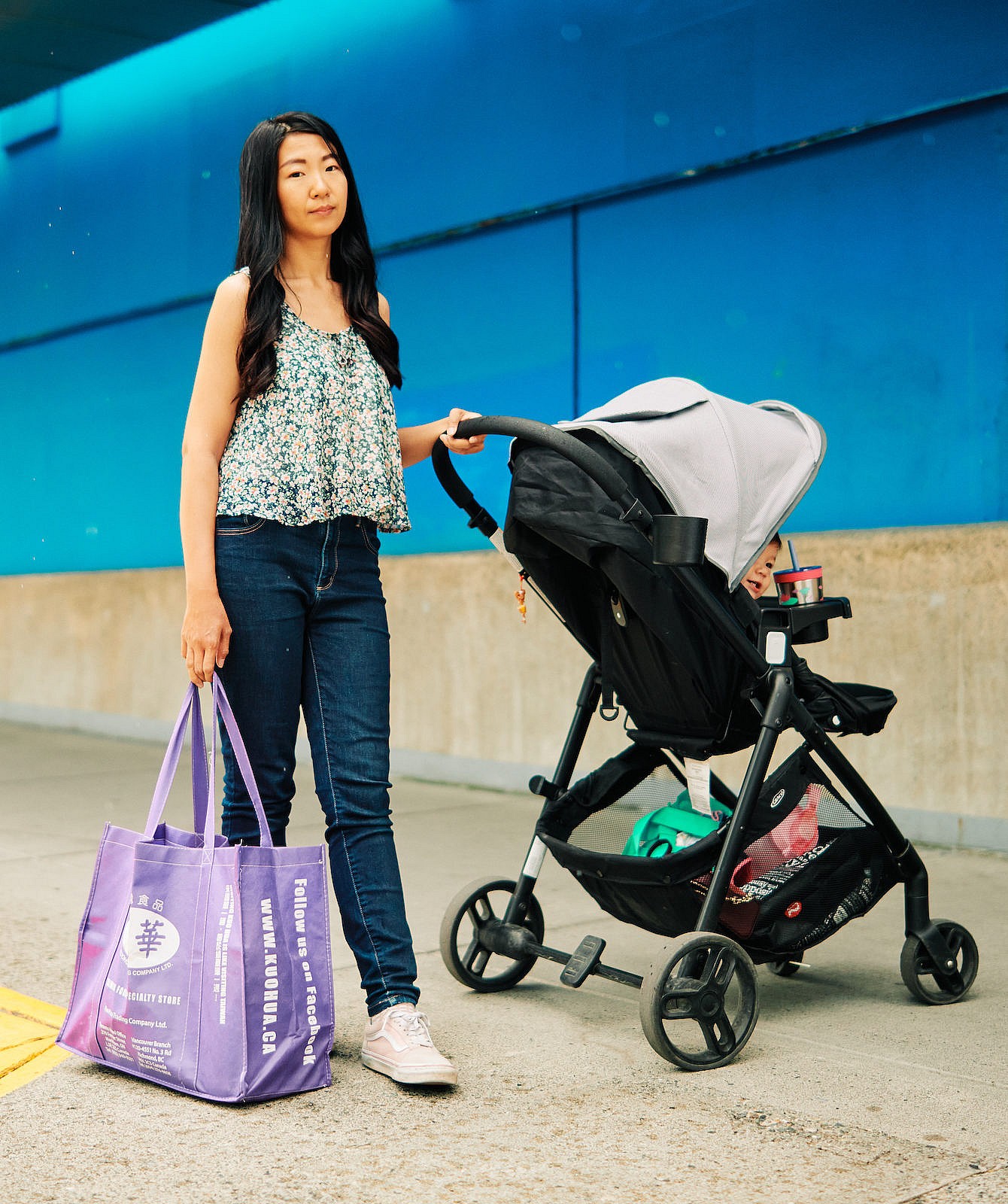The Food Diaries: Vancouver
“Technically I’m middle class. I have a good job. And yet we’re just getting by. Everything is going up except our income.”

(Photo by Mackenzie Walker)
Share
With the rising costs of nearly everything, Canadians are particularly feeling the pinch when it comes to rising food costs across the country, further fuelling a food insecurity crisis being experienced by many throughout the nation. Husna Shaikh, a talent acquisition team leader living in Vancouver and stay-at-home mom ChingYun Chien, also living in Vancouver, share their stories:
Husna Shaikh: My daughter and I always lived comfortably. I own a three-bedroom, 1,200-square-foot duplex, and I never had to pay attention to what I spent. If we needed something for the house, or if my six-year-old daughter, Zara, needed clothing, I just bought it. We’d go out to eat a couple of times a week, and I was still able to save some money.
It seemed like all of my costs started going up around the same time: groceries, gas, restaurants. One gas tank used to cost me about $60; it was $90 the last time I filled up. I have a variable interest rate, so my mortgage payments have increased by more than $800 a month. I don’t have any money left at the end of the month to save. I’ve even had to dip into my savings account to cover one-off expenses, like when my car needed an oil change, or when the electricity bill was higher than normal. If my mortgage payments continue to go up, I’ll have to go into my savings more often.
I needed to make some changes in order to make ends meet. I used to go to the Save-On-Foods for everything because it’s walking distance from our house. Now I’ll go to No Frills or Superstore because they’re cheaper. I use the Flipp app to find flyers, and I base my shopping around that. I’m buying no-name brands because they’re cheaper. For example, I used to buy Jamieson vitamins for about $15. Now I buy the Life brand for $5 or $10.
I’m also more conscious about buying fruit that lasts longer, like bananas instead of strawberries. We used to buy organic milk, but I was always worried about not using it up before it went bad. So now we get the Fairlife brand because it lasts longer. We drink every single drop.
My daughter understands that we can’t buy everything we want at the grocery store anymore. I used to get her things from the bakery, like cheese buns and croissants, for her lunches. Now I’ll pack her peanut butter sandwiches because they’re cheaper.
Sometimes I’ll buy items just because they’re on sale. It’s usually quick and easy dinner options. For example, PC brand ready-made quiches were recently on sale—$3 for a pack of four. We never used to eat much pasta, like ravioli, but we’re buying it more often now because it’s cheaper, it’s filling, and it’s easy to prepare.
In the past, during the summer, we’d go for a walk and get ice cream from a local shop in our neighbourhood, which would cost $8 or $10. These days, I’ll buy a box of eight Chapman ice cream bars for $5 so that we can have dessert at home.
It’s not just lower-income people who are being affected by inflation. Technically, I’m middle class. I have a good job and a good salary. And yet we’re just getting by. If the cost of living continues to increase, we’ll have to make more sacrifices, or I might start price matching with grocery store flyers, which I’ve never done before. I’m grateful to own a home and that my family never has to go hungry. But I am worried about expenses going up even more—especially my mortgage. — As told to Andrea Yu
***

ChingYun Chien:I moved from Taiwan to Vancouver in 2017 to study customer service at Greystone College. In 2018, I met Vance, and we married the following year. I worked as a travel agent, and he worked as a construction labourer. We could only just afford our expenses every month, but we never went into debt. We paid $1,400 a month for a one-bedroom apartment.
When COVID hit, I lost my job, and our daughter was born in March of 2021. Suddenly, we were paying an additional $100 each month on formula and diapers. Thankfully we got things like furniture, clothes and toys for free through a local moms’ group. The Canada child benefit also helped us cover the new expenses, but it still wasn’t enough. I learned about CityReach, a non-profit in Vancouver that offers food and supplies for families. I started going there in the summer of 2021, when my daughter was three months old. Every week, they give us a hamper stocked with fruit and vegetables, bread, canned items, vitamins, toilet paper and diapers. It helps us save about $40 to $50 every week. I’m not sure what we’d do without them. We’ll continue to get their hampers until my daughter gets into a daycare and I can go back to work.
Everything is going up except our income, and I’m shopping differently now. I used to buy brand-name items for things like jam, but now I’ll choose the no-name brand to save money. I’ll buy meat in bigger packs because it’s cheaper and freeze the extra portions. I’ve learned that if I bought a single beef steak, it would probably cost $10 a piece. But I buy a large club-sized cut of beef for $30 and can cut it myself into five or six steaks to save money. I also buy club-sized packs of Italian sausages to save money. When something is on sale, I’ll stock up on it. We never used to do that before. I buy Asian groceries at T&T, and other items at Superstore or Walmart. It can be exhausting to go to two or sometimes three places to buy groceries, but I know I can save some money doing that.
If I know my friends are going to Costco, I’ll ask them to buy some items for me. For $12, you can get a wheel of brie there that’s double the size but the same price as the brie from Superstore. Often we’ll buy a big pack of something, like croissants, and split it between us. My husband loves sweets, so sometimes I buy some Twix chocolate bars from Superstore or Walmart, but only if I have extra money. If I’m over my budget, then he doesn’t get any chocolate that week.
In the spring of 2022, my husband started working every second Saturday so he could earn more money. He’s tired all the time. We still like to do fun things with our daughter, like drive to North Vancouver to go on a hike and have a picnic. Even that’s difficult now that gas prices are so high.
I started applying to daycare waitlists when my daughter was three months old. A year later, we’re still waiting for a spot. I can’t go back to work until we can get her in somewhere. I hope to find a job as a garment purchaser, which is what I did back in Taiwan. Hopefully, when I start working again, our family’s finances will be less stressful.
— As told to Andrea Yu
This story is part of a series on food insecurity in Canada funded by the Maple Leaf Centre for Food Security, in partnership with Community Food Centres Canada.